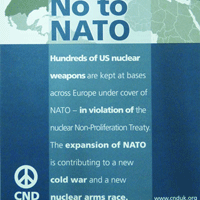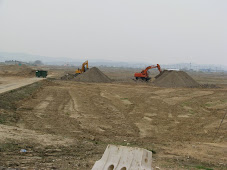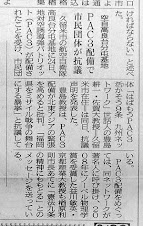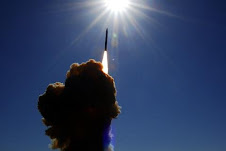Wednesday, December 23, 2009
Text Fwd: Lockheed Martin: U.S., Allies Advance Global Layered Missile Shield
'The USS Bunker Hill completed its operational trial of its full combat system, which includes Aegis Open Architecture, in August. This milestone is part of the development path to merge Aegis Open Architecture and Aegis BMD in 2012, when the Aegis Modernization program begins for the Navy's 62 Aegis-equipped destroyers.'
StopNATO
Lockheed Martin: U.S., Allies Advance Global Layered Missile Shield
Space War
SPX
Decmber 22, 2009
Critical Global BMD Milestones In 2009
-Lockheed Martin operational systems and next-generation capabilities address
each phase of missile defense - boost, ascent, midcourse and terminal - in
support of the U.S. Missile Defense Agency's (MDA) layered Ballistic Missile
Defense System (BMDS) and international allies' requirements.
-MEADS is designed to permit full interoperability between the U.S. and allied
armies, and it is the only medium-range air defense system to provide full
360-degree coverage.
Bethesda MD: Lockheed Martin missile defense systems achieved several key
milestones in 2009, including five successful intercepts and numerous other
major accomplishments, further solidifying Lockheed Martin as a world leader in
air and missile defense.
With 20 successful Aegis BMD intercepts, six successful Terminal High Altitude
Area Defense (THAAD) intercepts and 26 successful Patriot Advanced Capability-3
(PAC-3) Missile intercepts since the inception of those programs, Lockheed
Martin continues to build on its unmatched legacy as the pioneer of hit-to-kill
technologies.
"Lockheed Martin is proud to continue to lead ballistic missile defense efforts
for the United States and allied nations," said John Holly, vice president of
Lockheed Martin's newly established Missile Defense Systems operating unit,
based in Huntsville, AL.
....
Lockheed Martin operational systems and next-generation capabilities address
each phase of missile defense - boost, ascent, midcourse and terminal - in
support of the U.S. Missile Defense Agency's (MDA) layered Ballistic Missile
Defense System (BMDS) and international allies' requirements.
2009 Missile Defense Milestones - Weapons Systems
Aegis: In July, the Aegis BMD system destroyed a ballistic missile target in an
at-sea firing under operationally realistic conditions - marking the continued
successful engineering development of the next generational upgrade in Aegis BMD
capability.
The USS Bunker Hill completed its operational trial of its full combat system,
which includes Aegis Open Architecture, in August. This milestone is part of the
development path to merge Aegis Open Architecture and Aegis BMD in 2012, when
the Aegis Modernization program begins for the Navy's 62 Aegis-equipped
destroyers.
JS Myoko, Japan's third destroyer equipped with the Aegis BMD system,
successfully intercepted and destroyed a ballistic missile target above the
atmosphere during an October test event. Also that month, the MDA awarded a $1
billon follow-on contract providing for the integration of Aegis BMD into the
Aegis Modernization program and a contract vehicle for the next five years to
continue evolving BMD capability.
Additionally, the guided missile cruiser USS Lake Erie - using the latest Aegis
BMD baseline version 4.0.1 and new Aegis BSP signal processor - proved
successful during a series of long-range tracking, surveillance and engagement
exercises against a variety of ballistic missile targets in October.
MEADS: In July, the Medium Extended Air Defense System (MEADS) successfully
completed Critical Design Reviews (CDRs) for all major components, clearing the
way for production of radars, launchers, tactical operation centers, and
reloaders needed for system tests.
The program is on track to complete its final system-level CDR event in August
2010, with initial flight tests planned for 2012.
The program announced that it had received approval to use a European
cryptographic device to implement Identification Friend or Foe in October. The
selected subsystem makes both of the MEADS radars more robust than other current
U.S. systems and provides the highest level of fratricide prevention available
to protect coalition pilots.
MEADS is designed to permit full interoperability between the U.S. and allied
armies, and it is the only medium-range air defense system to provide full
360-degree coverage.
PAC-3 Missile: Lockheed Martin broke ground on an expansion of its
state-of-the-art PAC-3 Missile production complex in Camden, AR, in May. This
new facility will allow for continued production expansion and modest hiring of
new employees over the next several years.
In September, Airmen of the Japanese Self Defense Force and Lockheed Martin
successfully conducted the second Japanese PAC-3 Missile flight test at White
Sands Missile Range, NM.
The flight test demonstrated the Patriot Configuration-3 upgrades to Japanese
Patriot ground system, and the addition of the PAC-3 Missile Segment to detect,
track, engage and destroy a tactical ballistic missile target in a realistic
battlefield environment.
On December 11, Lockheed Martin successfully conducted the PAC-3 Missile PC-08
Flight Test at White Sands Missile Range, NM.
Preliminary test data indicates mission objectives were successfully achieved.
The test demonstrated system capability using Post Deployment Build -6.5
(PDB-6.5) software to search, detect, track, engage, and kill an aerodynamic
Tactical Ballistic Missile (TBM) using a ripple method of fire engagement.
THAAD: In March, Lockheed Martin and the U.S. Missile Defense Agency conducted
their sixth successful intercept in six attempts of the THAAD weapon system at
the Pacific Missile Range Facility in Kauai, HI. This flight test demonstrated
the system's ability to detect, track and intercept a separating target inside
the Earth's atmosphere.
This was the first salvo mission, with two THAAD interceptors launched against a
single separating target, which is a tactical option for the system. Data
indicates the first interceptor successfully destroyed the target while the
second interceptor destroyed a large piece of debris from the initial intercept.
This year, Lockheed Martin employees celebrated the 10th anniversary of the
first THAAD successful intercept and the 25th anniversary of the first
hit-to-kill intercept of a ballistic missile target outside of the Earth's
atmosphere.
In October, the U.S. Army and the MDA activated the second THAAD Battery at Fort
Bliss, TX, signifying the continued integration of THAAD into the U.S. Army's
Air and Missile Defense force structure. Unit training on the second THAAD
Battery is underway with equipment hardware deliveries slated to occur within a
year. 2009 Missile Defense Milestones - Next-Generation Capabilities and
Supporting Systems.
C2BMC: Command, Control, Battle Management and Communications (C2BMC) continues
to support real-world operations 24/7 around the world in 17 time zones,
supporting the Missile Defense Agency's strategic and regional objectives.
Logistics and Sustainment: In November, Global Aerospace Logistics, LLC (GAL),
Lockheed Martin and Raytheon announced the signing of a Joint Collaborative
Agreement that will establish world-class logistics and sustainment services for
the United Arab Emirates' air and missile defense systems.
Under the agreement, GAL will work with Raytheon and Lockheed Martin to develop
a logistics and sustainment capability to meet the immediate and future needs of
the UAE's air and missile defense strategy.
Targets and Countermeasures: Through 2009, Lockheed Martin's Targets and
Countermeasures Program has achieved 33 successful target missions out of 34
since 1996. Lockheed Martin's unmatched 97 percent reliability rate has included
unitary and separating targets, spanning land, sea and air launches.
In 2009, Lockheed Martin shipped the next-generation Launch Vehicle-2 target to
a test range in preparation for an upcoming test.
Space Based Infrared System (SBIRS): In November, the Lockheed Martin-led team
developing the Space Based Infrared System (SBIRS) program for the U.S. Air
Force successfully completed thermal vacuum testing of the first geosynchronous
(GEO-1) satellite, one of the most significant program milestones that validates
spacecraft performance in a simulated space environment.
The first SBIRS GEO spacecraft is planned for delivery to Cape Canaveral Air
Force Station in late 2010, where it will then undergo final processing and
preparation for launch aboard an Atlas V launch vehicle.
===========================
Stop NATO
Subscribe to:
Post Comments (Atom)


![[URGENT PLEA: In Update] EMERGENCY in GANGJEONG Since AUG. 24, 2011](http://2.bp.blogspot.com/-3iz8k-USXVY/TlmRYhhIYtI/AAAAAAAAL2c/9dbF85ZIkIs/s227/jejusit.jpg)



![[Solidarity from Japan for the Jeju] 253 individuals and 16 groups/organizations](http://2.bp.blogspot.com/_gnM5QlRx-4c/TR_YeNVE1yI/AAAAAAAAHWQ/ARyf6oQN0S0/S227/jeju_12_10j.jpg)

![[Translation] Korean organizations' statement: Immediately cancel the joint ROK-US drill Nov 26](http://2.bp.blogspot.com/_gnM5QlRx-4c/TPOE8VKXHFI/AAAAAAAAGlM/8lryt-8sFjc/S227/1.jpg)
![HOT! [Hankyoreh Hani TV] Beneath the Surface: the investigation into the sinking of the Cheonan](http://4.bp.blogspot.com/_gnM5QlRx-4c/TOI83qht8aI/AAAAAAAAGXU/22SW6Q5ntV8/S227/HaniTV%2BCheonan.gif)



![[Translation]Statement against illegal inspection and unjust lay-off by the Kunsan USAFK!(Nov_2010)](http://4.bp.blogspot.com/_gnM5QlRx-4c/TOPLsVkZMqI/AAAAAAAAGZs/3YnnckIyAaY/S227/gunsan%2Bprotest.gif)
![[Translation] Korean organizations' statement against dispatching special force to the UAE on Nov.](http://4.bp.blogspot.com/_gnM5QlRx-4c/TOP95zHXlCI/AAAAAAAAGak/E0Ug1XtUFfM/S227/antiwarpeace.jpg)
![[Translation] Stop, Joining MD!: South Korean activists' statement and writing on Oct. 25, 2010](http://3.bp.blogspot.com/_gnM5QlRx-4c/TOP7Es4_2sI/AAAAAAAAGac/eWVMPD-U4p0/S227/StopMD.jpg)
![[In Update] People First, NO G-20 (Nov. 6 to 12, Korea)](http://2.bp.blogspot.com/_gnM5QlRx-4c/TJd53XBzHlI/AAAAAAAAFQo/ldO9JPE3eqo/S227/left21_G20.jpg)
![[International Petition] Stop US helipad plan in Okinawa to save great nature](http://4.bp.blogspot.com/_gnM5QlRx-4c/TKC2AHRNzBI/AAAAAAAAFUo/yGWXODTw_uM/S227/yanbaru_w.jpg)

![[Global Network] against the first launch of Quasi-Zenith Satellite, Japan, on Sept. 11, 2010](http://4.bp.blogspot.com/_gnM5QlRx-4c/TIowa1boy4I/AAAAAAAAFDI/82rAi98uq-c/S227/Qzss-45-0_09.jpg)

![[In update] Some collections on the Koreans’ protests against the sanction & war on Iran](http://4.bp.blogspot.com/_gnM5QlRx-4c/TJMvke6t8zI/AAAAAAAAFO4/tamQ8LUnOOA/S227/No+Sanction+on+Iran.jpg)
![[Three International Petitions] to End the Korean war and peace treaty(or peace resolution)](http://1.bp.blogspot.com/_gnM5QlRx-4c/THef7bzWxYI/AAAAAAAAE44/wwdzSDfYhdw/S227/border.jpg)



![[Collection of Documents] No Base Learning and Solidarity Program_Korea(June 14 to 20, 2010)](http://1.bp.blogspot.com/_gnM5QlRx-4c/TCTvVuN8NeI/AAAAAAAAEek/8vBJVaHdk10/S227/No-Base-banner.jpg)
![Site Fwd:[John Hines] A U.S. Debate coach’s research trip on the Issues of Korea](http://3.bp.blogspot.com/_gnM5QlRx-4c/TINCO36mzzI/AAAAAAAAE_w/Rds12NcBOXM/S227/Jeju-Peace-Tour.jpg)


![[News Update] Struggle Against the Jeju Naval Base since Jan. 18, 2010](http://1.bp.blogspot.com/_gnM5QlRx-4c/S1vvWaP25uI/AAAAAAAACkg/QvpW1tgOlKM/S226/scrum1.jpg)


![[Urgent] Please spread the Letter!: There was no Explosion! There was no Torpedo! (May 26, 2010)](http://4.bp.blogspot.com/_gnM5QlRx-4c/S_9JmsKEU7I/AAAAAAAAEP8/sAWjSPqxzUI/S227/grounded.jpg)
![Text Fwd: [Stephen Gowans]The sinking of the Cheonan: Another Gulf of Tonkin incident](http://1.bp.blogspot.com/_gnM5QlRx-4c/TAL_FtYKQ-I/AAAAAAAAERE/NEEMijiEcRM/S227/lee-myung-bak.jpg)
![[Japan Focus]Politics in Command: The "International" Investigation into the Sinking of the Cheonan](http://1.bp.blogspot.com/_gnM5QlRx-4c/TBMJ2syJzyI/AAAAAAAAEZU/uTYZccU5vyk/S227/wen_jiabao_and_lee_myungbak.png)
![[Japan Focus] Who Sank the SK Warship Cheonan? A New Stage in the US-Korean War and US-China](http://2.bp.blogspot.com/_gnM5QlRx-4c/S_iQ2vE5ZpI/AAAAAAAAEOU/Oo1SPcAe8FE/S227/buoy_map.gif)
![[Updated on 12/13/10] [Translation Project] Overseas Proofs on the Damages by the Military Bases](http://4.bp.blogspot.com/_gnM5QlRx-4c/S-qSj59gPLI/AAAAAAAAEGM/mwjlFtPE-jo/S227/missile.jpg)
![[International Petition] Close the Bases in Okinawa](http://3.bp.blogspot.com/_gnM5QlRx-4c/S8-z3DYNwNI/AAAAAAAADo4/OswTSchK09M/S227/2.jpg)

![[In Update]Blog Collection: No Korean Troops in Afghanistan](http://4.bp.blogspot.com/_gnM5QlRx-4c/SwnlLD9IewI/AAAAAAAAB9E/oUPssnpNidA/S226/No-Troops-to--Afghanistan.jpg)











No comments:
Post a Comment